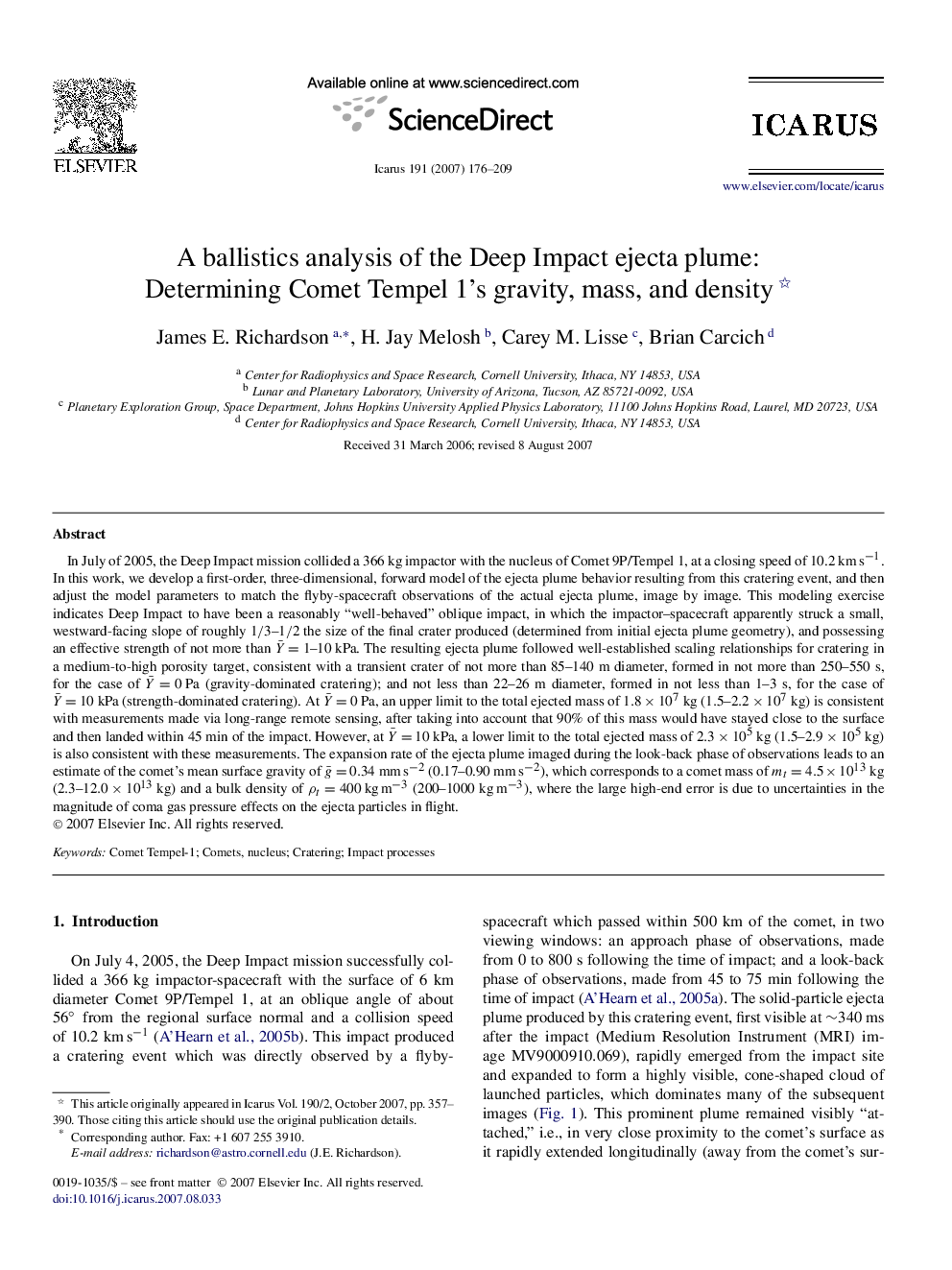| کد مقاله | کد نشریه | سال انتشار | مقاله انگلیسی | نسخه تمام متن |
|---|---|---|---|---|
| 1775245 | 1021188 | 2007 | 34 صفحه PDF | دانلود رایگان |
عنوان انگلیسی مقاله ISI
A ballistics analysis of the Deep Impact ejecta plume: Determining Comet Tempel 1's gravity, mass, and density
دانلود مقاله + سفارش ترجمه
دانلود مقاله ISI انگلیسی
رایگان برای ایرانیان
کلمات کلیدی
موضوعات مرتبط
مهندسی و علوم پایه
علوم زمین و سیارات
علوم فضا و نجوم
پیش نمایش صفحه اول مقاله

چکیده انگلیسی
In July of 2005, the Deep Impact mission collided a 366 kg impactor with the nucleus of Comet 9P/Tempel 1, at a closing speed of 10.2 kmâsâ1. In this work, we develop a first-order, three-dimensional, forward model of the ejecta plume behavior resulting from this cratering event, and then adjust the model parameters to match the flyby-spacecraft observations of the actual ejecta plume, image by image. This modeling exercise indicates Deep Impact to have been a reasonably “well-behaved” oblique impact, in which the impactor-spacecraft apparently struck a small, westward-facing slope of roughly 1/3-1/2 the size of the final crater produced (determined from initial ejecta plume geometry), and possessing an effective strength of not more than Y¯=1-10 kPa. The resulting ejecta plume followed well-established scaling relationships for cratering in a medium-to-high porosity target, consistent with a transient crater of not more than 85-140 m diameter, formed in not more than 250-550 s, for the case of Y¯=0 Pa (gravity-dominated cratering); and not less than 22-26 m diameter, formed in not less than 1-3 s, for the case of Y¯=10 kPa (strength-dominated cratering). At Y¯=0 Pa, an upper limit to the total ejected mass of 1.8Ã107 kg (1.5-2.2Ã107 kg) is consistent with measurements made via long-range remote sensing, after taking into account that 90% of this mass would have stayed close to the surface and then landed within 45 min of the impact. However, at Y¯=10 kPa, a lower limit to the total ejected mass of 2.3Ã105 kg (1.5-2.9Ã105 kg) is also consistent with these measurements. The expansion rate of the ejecta plume imaged during the look-back phase of observations leads to an estimate of the comet's mean surface gravity of g¯=0.34 mmsâ2 (0.17-0.90 mmâsâ2), which corresponds to a comet mass of mt=4.5Ã1013 kg (2.3-12.0Ã1013 kg) and a bulk density of Ït=400 kgmâ3 (200-1000 kgâmâ3), where the large high-end error is due to uncertainties in the magnitude of coma gas pressure effects on the ejecta particles in flight.
ناشر
Database: Elsevier - ScienceDirect (ساینس دایرکت)
Journal: Icarus - Volume 191, Issue 2, Supplement, 2007, Pages 176-209
Journal: Icarus - Volume 191, Issue 2, Supplement, 2007, Pages 176-209
نویسندگان
James E. Richardson, H. Jay Melosh, Carey M. Lisse, Brian Carcich,